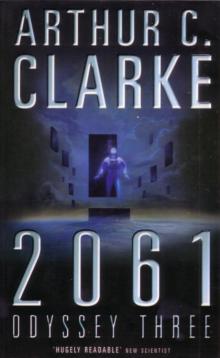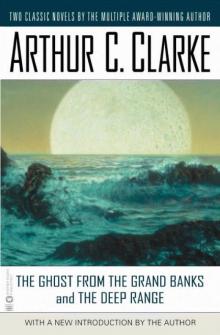- Home
- Arthur C. Clarke
Cradle
Cradle Read online
Cradle
Arthur C. Clarke
Gentry Lee
Copyright
Cradle
Copyright © 1988 by Arthur C. Clarke and Gentry Lee
Cover art to the electronic edition copyright © 2012 by RosettaBooks, LLC.
All rights reserved. No part of this book may be used or reproduced in any form or by any electronic or mechanical means, including information storage and retrieval systems, without permission in writing from the publisher, except by a reviewer who may quote brief passages in a review.
Electronic edition published 2012 by RosettaBooks, LLC, New York.
ISBN e-Pub edition: 9780795325069
Dedication
This book is dedicated to the four youngest
children in our families,
Cherene, Tamara, Robert, and Patrick.
May their lives
be filled with joy and wonder.
Content
Endangered Species
Thursday
1
2
3
4
5
6
7
8
9
10
Cycle 447
1
2
Friday
1
2
3
4
5
6
7
8
9
Assembly and Test
Saturday
1
2
3
4
5
6
7
8
9
10
Repatriation
Sunday
1
2
3
Credits
ENDANGERED SPECIES
The emerald water smashes against the dark volcanic cliffs. Fine white spray hovers over the harsh rock, creating a misty veil that glimmers in the fading light. In the distance, two yellow suns set simultaneously, separated by about forty degrees as they disappear together below the horizon. Across the blue-black sky, on the opposite side of the isthmus that slopes gently downward from the volcanic cliffs to another ocean, a pair of full moons rises as the two suns vanish. Their twin moonlight, although much weaker than the shine of the disappearing suns, is still strong enough to create dancing moonshadows on the ocean beneath the rocky overhang.
As the dual moons rise on the eastern side of the isthmus, light begins to glow on the horizon beside them, about twenty degrees to the south. At first the glow looks like the light of a distant city, but with each passing moment it brightens until it spreads across the sky. At length an awesome third moon, its first chord coming over the horizon when the twin moons are perhaps ten degrees into their arc, begins to rise. Calm descends on both oceans for a few seconds, as if the world beneath the giant orb has paused to give homage to the spectacular sight. This great yellow moon, its face clearly scarred by craters, appears to be surveying its dominion as it slowly rises in the sky and bathes the emerald oceans in a mysterious reflected light. It is a hundred times the size of the smaller twin moons and its wide swath through the sky is greater in size than that cut minutes before by the pair of setting suns.
Below the cliffs, in the shadow of the newest moon, a long sinuous object arcs its way out of the water, rising nearly twenty feet above the surface. The slender apparition twists itself toward the cliffs and thrusts itself forward as the piercing sound of a trumpet, a solo blast, reverberates against the rocks and carries across the isthmus. A moment later another sound is heard, a muted echo or possibly a reply from the other sea. The creature swims gracefully into the moonlight, its long, lithe neck a cobalt blue above a grey body mostly submerged in the ocean. Now the bluenecked serpent extends itself upward again and leans toward the land, its face revealed in the expanding moonlight. The facial features are convoluted and complex, with rows of orifices of unknown purpose. At the peak of its extension, the creature contorts its face and a medley of sound is heard; the trumpet blast is now accompanied by an oboe and an organ. After a short pause a muted response, quieter but with the same rich complexity of sound, comes back across the isthmus.
The serpent swims north along the shore. Behind it in the moonlight half a dozen other swirling necks rise from the ocean. These creatures are a little smaller, the hues of their cobalt necks not quite so vivid. This ensemble turns as one, on cue, and blasts six trumpet calls to the east. Again a pause precedes the expected response, the sound of several smaller trumpets from across the land. Immediately the six new creatures and their distant friends begin a complex, interleaved musical pattern, slowly building in intensity until the overture reaches an inevitable crescendo and then abruptly abates.
After a few moments more the oceans on both sides of the isthmus become alive with teeming serpents of all sizes. Hundreds, even thousands, of serpents, covering the water for as far as the eye can see, begin languorously extending their necks, twisting as if looking around, and joining in the singing. The serpents of the eastern sea are slightly smaller than their western cousins. The necks of the eastern serpents are pale blue instead of cobalt. These pale blue serpents are also joined by a nursery of tiny creatures, the palest of blue markings on their necks, whose singing is high-pitched and a trifle erratic and sounds like piccolos interspersed with crystal bells.
The waters of the emerald oceans begin to surge forward in tidal frenzy, now rapidly moving up the rocky cliffs on the western side and quickly submerging great chunks of land on the sloping side that runs to the eastern ocean. The concerted pull of all the moons produces a tide that will eventually cover the isthmus completely, uniting the two oceans. As the waters draw ever closer together, the music from the thousand singing serpents swells to magnificence, flooding the entire area with a sound of mesmerizing beauty. It is also a plaintive sound of longing and anticipation, the universal cry of long suppressed desire on the verge of being satisfied.
The great longnecked serpents of Canthor conclude their annual mating symphony as the two oceans become one and the inhabitants of each ocean seek out their lifelong mates in the united waters. There are five nights out of each Canthorean year when the tidal forces act together to submerge the isthmus and permit the sexual mixing of the serpents. Five nights of love play and frolicking, of renewal and promise, before the requisite return to the separate oceans and a year of waiting for the great tide to come again.
For the little ones, the new serpents placed into gestation by the last annual gathering and hatched by their mothers in the eastern ocean, the great tide is a time of excitement and sadness. They must now separate from their playmates, leave their infancy behind. Half must depart from their mothers as well and go to swim among the cobalt blue adults that they have never met. This half, having lived their lives among their mothers’ friends exclusively, will swim above and across the isthmus on the fifth night alongside their fathers. Once into the western ocean, their pale blue necks will begin to deepen in colour as they begin the transition through puberty into adulthood. And next year, their tiny voices will have matured just enough that each of them may detect some arousing and positive response to his call during the mating symphony.
Thousands of years pass on the planet Canthor. The forces of change conspire against the beautiful bluenecked serpents. First a major ice age comes to the world, locking up more of the planet’s water in perennial polar caps and lowering the seas. The number of days when the great tide submerges the isthmus is reduced to four, then three, and finally only two. The elaborate mating ritual of the serpents, worked out over hundreds of generations, works best for a five-night courtship. For the several hund
red years when only two nights are available for mating, the number of serpent offspring produced each year drops precipitously. The total number of Canthorean serpents becomes dangerously small.
At length the radiative output of the dual suns increases slightly again and Canthor emerges from its ice age. The sea level rises and the number of days for mating returns eventually to five. The serpent symphony, which had added a saddened counterpoint during the trying years of reduced mating nights, again becomes charged with joy. For several generations the number of serpents increases. But then the lovely creatures encounter another foe.
Evolving elsewhere on Canthor for almost a million years has been another intelligent species, a fierce, squat creature with an insatiable appetite for control. The ice age stimulated the rapid evolution of these trolls by enforcing a strict survival of the fittest which naturally selected those individuals with the most resources (intelligence and power primarily) and, in a sense, purified the troll gene pool.
The troll species that emerges from the thousands of years of ice domination on Canthor is sharper and more capable of dealing with the rest of its environment. It has become a tool maker and has learned how to use the riches of the planet for its benefit. No other living creatures on Canthor can match the cleverness of the trolls or threaten their existence. So the trolls proliferate around the planet, dominating it completely with their rapaciousness.
The bluenecked serpents have had no natural enemies on Canthor for hundreds of millennia. Therefore they have not retained the aggression and territoriality necessary to survive when threatened. Their diet has always consisted primarily of plants and animals that fill the Canthorean oceans. The seas provide a virtual cornucopia of food, so it does not make much of an impression upon the serpents when the trolls begin to farm the oceans for their own food. To the trolls, however, whose greed for territory knows no bounds, the serpents represent at least a rival for the plenty of the oceans and possibly, because of their size and intelligence, even a survival threat.
It is again the time of the great tide and the male longnecked serpents have completed their ocean migration on time, swarming as usual just opposite the great volcanic cliffs. There are only a few hundred male serpents now, reduced markedly from the halcyon years when they were so numerous they stretched as far as the eye could see. The giant full moon rises as it has for thousands of years, following the twin smaller moons into the sky, and the overture announces the coming mating symphony. But as the tide rolls in to submerge the isthmus, the serpents sense that something is wrong. A growing cacophony creeps into the mystical mating song. Anxiety spreads by sound across both sides of the land separating the serpents. When the tide finally surges over the top of the volcanic rocks, the point in the original mating symphony for the magnificent final crescendo, the sound of the serpents’ pleading wail fills the Canthorean night.
The trolls have erected a huge barrier down the spine of the isthmus. Carefully calculated to be just tall enough to preclude passage to the largest of the serpents, this oppressive barrier allows the lovely bluenecked creatures, if they strain, to sense one another at close range but not to touch. The nights of the great tide are extremely painful to watch. From both sides the serpents hurl themselves repeatedly and ineffectually at the wall, trying desperately to make contact with their mates. But it is all in vain. The barrier holds. The serpents are unable to mate. Both sexes return eventually to their respective oceans, deeply saddened and profoundly aware of the implications of the barrier for their future.
Some of the serpents batter themselves nearly senseless as they try to break down the wall. These wounded ones on both sides of the isthmus remain behind to recover while the rest of the species, resuming the annual migration as if the normal mating had indeed taken place, slowly and sadly swim away, each sex heading for a separate reach of Canthor.
It is two nights after the great tide has stopped submerging the land between the oceans. Two older male serpents, their necks still bruised from the repeated fruitless hammerings against the hated barrier, are swimming slowly together in the moonlight. A strange light in the sky comes swiftly upon them from above. It hovers over the serpents, seeming to spotlight them as they crane their necks to see what is happening.
In a moment the graceful necks keel forward and slap down upon the moonlit ocean. From out of the light above them comes an object, a basket of some kind, that descends to the water. The two serpents are scooped up, lifted silently out of the sea into the air, reeled in by some unknown fisherman in the sky above them. The same scene is repeated a dozen times, first in the western ocean with the wounded serpents whose necks are cobalt blue, then in the eastern ocean with their pale blue counterparts. It is as if a great roundup is taking place, removing all the exhausted serpents who had been unable to take their place with the rest of the species in the annual migration.
Far above Canthor a gigantic cylindrical spaceship awaits the return of its robot minions. Twenty miles on a side, this travelling planet opens itself to a fleet of returning vehicles the size of large aeroplanes that bring back the quarry from Canthor. The cylinder rotates slowly as Canthor and its giant moon shine in the background. A solo laggard vehicle returns, a door opens to receive it in the back of the larger craft, and for a while there is no more activity. At length the cylinder tips over on its side and fires several small rockets. It is out of sight in seconds, departing Canthor for other worlds.
The snow falls steadily on the huge man trudging silently through the forest. Clad in skins, carrying a heavy load on his back and a large spear in one hand, he turns his hairy unkempt face toward the others behind him, his family, and grunts at them to hurry. There are five altogether, an infant carried by the woman and two teenage children. The teenagers are wearing skins like their parents and have large bundles slung across their backs. The teenage boy is also carrying a spear. At close distance all of them look very weary, almost exhausted.
They break free from the forest for a moment and enter a meadow that surrounds a frozen pond. The snow continues to fall, adding to the three inches that already cover the ground. The father motions to his family to stop and approaches the pond gingerly. As the others huddle together against the cold, the man takes a crude tool from his bundle and, after brushing the snow off the surface of the pond in a small area, begins to cut the ice. Almost an hour passes. Finally he succeeds, utters a grunt of happiness, and bends down to drink the water. He pulls out a skin, fills it, and brings the water to his wife and children.
The teenage daughter smiles at her father, a smile of love and admiration, as he offers her the water. Her face is tired, etched with the lines of sun and wind and cold. She reaches up to take the skin. Suddenly her face contorts with fear, she screams, and her father turns just in time to protect himself from a snarling wolf, poised in midair in attack. He strikes the wolf forcefully with his powerful arm, knocking it away from its target, and then stumbles toward his spear on the ground beside the pond. He grabs the spear and turns around quickly, prepared to defend his family.
Three wolves have attacked them. His son has deftly impaled one of the animals through the midriff with his spear, but now a second wolf has pinioned the boy, defenceless, in the snow, before he has been able to withdraw his weapon and strike again. In a frenzy, the father jumps forward and thrusts his spear into the wolf attacking his son. But it is too late. The hungry predator has already found the boy’s throat, severing the jugular vein with one quick snap of his powerful jaws.
Whirling around, the caveman moves against the last of the wolves. His wife lies bleeding in the snow and his infant child is unprotected, screaming in its wrappings some twenty feet from the mother. The last wolf, wary of the huge man, feints an attack against the father and then leaps for the baby. Before the man can respond, the wolf has grabbed the baby by its clothes and headed off for the forest.
The young girl is spared physical injury in the attack but is devastated by the near-instant death of
her brother and the disappearance of her tiny sister. She holds her dead brother’s hand and sobs uncontrollably. Her father stuffs virgin snow in his wife’s wounds and then lifts her upon his back along with the heavy bundles. He grunts a couple of times to his daughter and she finally, reluctantly, picks herself up and starts gathering what remains of the family’s things into another bundle.
As night falls the three surviving members of the family are approaching some caves at the edge of the forest. The father is near exhaustion from the weight of his wife and the family’s meagre belongings. He sits down to rest for a moment. His daughter stumbles down beside him, placing her head in his lap. She cries silently and her father tenderly wipes away her tears. A bright light suddenly shines down on them from above and an instant later all three are unconscious.
A tethered metallic basket about fifteen feet long and five feet wide descends in the eerie snowy light and comes to rest softly on the ground beside the three humans. The sides of the basket drop and metal belts extend themselves outward, wrapping around each of the people. They are pulled into the basket, the sides of the basket are closed, and the strange object then ascends into the snowy night. Seconds later the spotlight disappears and life returns to normal in the prehistoric forest.
Above the Earth the giant cylinder sits quietly, waiting for its messengers to return. The planet below is nearly cloudless and the great blue stretches of ocean tremble like jewels in the reflected sunlight. Near the evening terminator, the low sun angles show a vast expanse of ice extending down from the North Pole, covering almost all of a large continent. To the west, across a great ocean and an all white northern island, the midday sun shines on another large continent. It is also mostly covered by ice. Here the ice extends southward across two thirds of the land mass and only disappears completely as the continent begins to taper and the southern sea is reached.
The hunting shuttles sent out from the great cylinder return to their base and unload their prey. The father, injured mother, and teenage daughter are inside the small shuttle craft along with fifty to sixty other humans, selected from disparate points around the world. None of the humans is moving. After the shuttle safely docks with the mother ship, all the prehistoric humans are moved in a large van to a receiving station. Here they are admitted and catalogued, and then taken inside a vast module that re-creates the environment of Earth.

 Time's Eye
Time's Eye The Sentinel
The Sentinel Prelude to Space
Prelude to Space Earthlight (Arthur C. Clarke Collection)
Earthlight (Arthur C. Clarke Collection) 2001: A Space Odyssey
2001: A Space Odyssey Against the Fall of Night
Against the Fall of Night Glide Path
Glide Path The Lost Worlds of 2001
The Lost Worlds of 2001 The Trigger
The Trigger Reach for Tomorrow
Reach for Tomorrow Islands in the Sky
Islands in the Sky The Songs of Distant Earth
The Songs of Distant Earth 2010: Odyssey Two
2010: Odyssey Two Childhood's End
Childhood's End 3001: The Final Odyssey
3001: The Final Odyssey The Fountains of Paradise
The Fountains of Paradise Rama: The Omnibus
Rama: The Omnibus The Hammer of God
The Hammer of God Beyond the Fall of Night
Beyond the Fall of Night Tales From Planet Earth
Tales From Planet Earth 2061: Odyssey Three
2061: Odyssey Three Tales From the White Hart
Tales From the White Hart The City and the Stars/The Sands of Mars
The City and the Stars/The Sands of Mars The Star
The Star Imperial Earth
Imperial Earth The Light of Other Days
The Light of Other Days Firstborn
Firstborn The Other Side of the Sky
The Other Side of the Sky Cradle
Cradle The Wind From the Sun
The Wind From the Sun The Ghost From the Grand Banks and the Deep Range
The Ghost From the Grand Banks and the Deep Range The Deep Range
The Deep Range Expedition to Earth
Expedition to Earth A Fall of Moondust
A Fall of Moondust Dolphin Island (Arthur C. Clarke Collection)
Dolphin Island (Arthur C. Clarke Collection) Richter 10
Richter 10 The City and the Stars
The City and the Stars Tales of Ten Worlds
Tales of Ten Worlds Dolphin Island
Dolphin Island Expedition to Earth (Arthur C. Clarke Collection: Short Stories)
Expedition to Earth (Arthur C. Clarke Collection: Short Stories) Sunstorm
Sunstorm Rendezvous with Rama
Rendezvous with Rama The Collected Stories of Arthur C. Clarke
The Collected Stories of Arthur C. Clarke Trouble with the Natives
Trouble with the Natives Rama Revealed r-4
Rama Revealed r-4 The Sixth Science Fiction Megapack
The Sixth Science Fiction Megapack Firstborn to-3
Firstborn to-3 The Ghost from the Grand Banks
The Ghost from the Grand Banks Into the Comet
Into the Comet The Fires Within
The Fires Within 2061: Odyssey 3
2061: Odyssey 3 The Ninth Science Fiction Megapack
The Ninth Science Fiction Megapack The Coast of Coral
The Coast of Coral The Ghost from the Grand Banks (Arthur C. Clarke Collection)
The Ghost from the Grand Banks (Arthur C. Clarke Collection) The Space Trilogy
The Space Trilogy A Meeting With Medusa
A Meeting With Medusa 2001: A Space Odyssey (Arthur C. Clarke Collection: The Odyssey)
2001: A Space Odyssey (Arthur C. Clarke Collection: The Odyssey) Islands in the Sky (Arthur C. Clarke Collection)
Islands in the Sky (Arthur C. Clarke Collection) Rama II r-2
Rama II r-2 Glide Path (Arthur C. Clarke Collection)
Glide Path (Arthur C. Clarke Collection) The Sixth Science Fiction Megapack: 25 Classic and Modern Science Fiction Stories
The Sixth Science Fiction Megapack: 25 Classic and Modern Science Fiction Stories Tales from the White Hart (Arthur C. Clarke Collection: Short Stories)
Tales from the White Hart (Arthur C. Clarke Collection: Short Stories) The Reluctant Orchid
The Reluctant Orchid